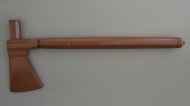A stone tomahawk
November 2015

Among the Indian tribes of North America, the use of stone for the manufacture of pipe bowls is widespread. Most commonly used is what is called pipe stone or catlinite from southwestern Minnesota, characterized by a soft red colour. Traditional and best known is the ceremonial peace pipe or calumet made out of this type of stone. In addition to this peace pipe, there is the war variant or tomahawk. It is shaped like an ax with a pipe bowl on top, opposite the sharp side of the ax. The standard tomahawk is forged from iron or cast from brass and has a wooden stem pierced for the smoke tube. The pipe discussed here is an interesting and rare alternative: a tomahawk in shape, but executed in the catlinite typical for the peace pipe. Even the stem is made of the same stone. The pipe consists of two parts. The bowl part with a cylindrical pipe bowl at the top, the triangular ax shape at the base. This ax is faceted on the edges as if it was really meant for chopping. The stem, also made of solid stone, is decorated with a pair of bands with concentric rings. Bowl and handle are attached to each other with a piece of wood, at the end there is a wooden insert as a mouthpiece. This stone battle ax is absolutely unsuitable as a hatchet or throwing ax, which underlines its ceremonial function. It is even more likely that the pipe is made as a commodity, as a decorative pipe. This pipe must have been sold as a curiosity in the nineteenth century to a visitor to a native Indian tribe. Nevertheless, it has seriously served as a smoking pipe as evidenced by the considerable carbon deposition in the bowl of the pipe.
Amsterdam Pipe Museum APM 22.066
Archive object of month